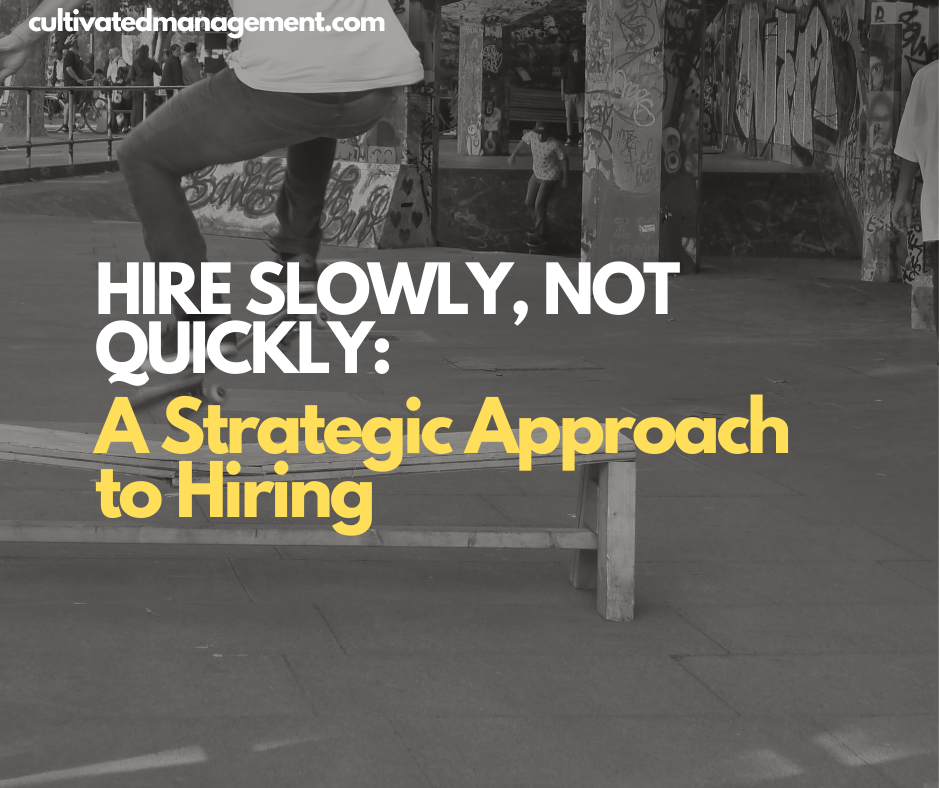
I keep seeing the phrase “Hire Fast, Fire Fast” pop up on LinkedIn.
The idea is simple:
Get people through the door quickly, and if they don’t work out, let them go just as quickly.
It sounds bold. Efficient. Even entrepreneurial.
But I don’t buy it. In fact, I think it’s one of the fastest ways to damage your people, your reputation, and your company.
Instead, I believe in “Hire Slowly, Fire Fast.”
Watch the video or read on for more.
1. It’s unfair on candidates
Hiring fast plays with people’s lives.
I’ve seen this happen: someone leaves a stable job, often lured by a higher salary or the promise of growth. Within weeks, they’re out again. CV dented and confidence knocked.
You create a blip on their CV. You give them the comfort of finding a job, then the uncertainty and emotional challenge of being “let go”.
Yes, every job carries risk, but if you didn’t even set clear expectations or define what success looks like, and they don't meet that bar, that’s on you as the employer.
People rarely forget how you made them feel. Treat them fairly. Hire slowly.
2. Firing isn’t painless
Even during probation, firing someone isn’t easy. There’s emotional fallout for the individual, the manager, HR, and the wider team.
Paul Hawken wrote in Growing a Business (affiliate link):
“Firing is failure. Everybody is at fault. The best way to avoid firing people is to hire well in the first place.”
Firing should never be your Plan A.
3. “Am I next?”
Every dismissal creates ripples.
When colleagues see high turnover, they start whispering: “Am I next?”
I’ve been in those environments and it breeds anxiety, not performance.
Anxious teams don’t do their best work. Stability matters.
4. The wrong person can cause real damage
It doesn’t take long for a poor hire to lower standards, frustrate colleagues, or lose customers.
Hiring slowly isn’t about bureaucracy—it’s about protecting the culture and momentum you already have.
5. People take time
Not everyone hits the ground running. Some people need more direction, or simply more time.
If your default mindset is “hire fast, fire fast,” managers are less likely to invest in developing people.
What looks like a “bad hire” may just be someone adjusting. If your system doesn’t allow for that, you’ll burn through good people unnecessarily.
6. The hidden costs
Hiring is expensive: job ads, recruiter fees, HR, onboarding, IT, admin.
Firing adds another layer of cost: lost productivity, team morale, and time wasted managing underperformance.
When you hire recklessly, you’re not just gambling with someone’s career you’re burning your investors’, shareholders’ or customers’ money.
7. Do you really need someone that quickly?
If the business is desperate for capacity, consider contractors or freelancers while you search for the right permanent hire.
Fast doesn’t always mean effective. And in the long run, you want effective.
8. Bad hires steal your time
Every hour you spend managing low performance is an hour you’re not growing the business.
Wouldn’t you rather put that time into careful hiring up front, rather than repeating the same painful cycle again and again?
9. You’re always sending signals
Your team is watching how you hire.
A slapdash process tells them you don’t care who joins the team. Worse, it sends the message that maybe they were just a gamble too.
High standards in hiring build trust.
10. The cost of “making do”
Here’s what often happens with a bad hire: they stay.
Managers avoid tough conversations, shuffle them sideways, or keep them to avoid the hassle of firing. Teams bloat. High performers leave. Average becomes the norm.
And the longer that goes on, the harder it is to attract great people.
So what’s the alternative?
Hire slowly. Fire fast.
That means:
- Focus on behaviours as much as skills.
- Set a high bar for performance and communicate expectations clearly.
- Streamline your recruitment process - good people are interviewing you too.
- Use referrals, brand ambassadors, and trusted recruiters.
- Train your managers to interview well—ask behavioural questions, read non-verbal cues, avoid illegal questions.
When you take your time, you raise the bar. You won’t always get it right—but you’ll get it right far more often. And when it doesn’t work out, deal with it quickly and professionally.
👉 Get loads of great ideas about recruiting and building an awesome induction processes, in my book "Join Our Company".
Final thought
Hiring is one of the most critical activities in any business. Get it right, and you multiply the impact of your whole team. Get it wrong, and you pay for it—in money, morale, and momentum.
So don’t gamble with “hire fast, fire fast.”
Instead, hire slowly, fire fast—and build a company where the right people thrive.
